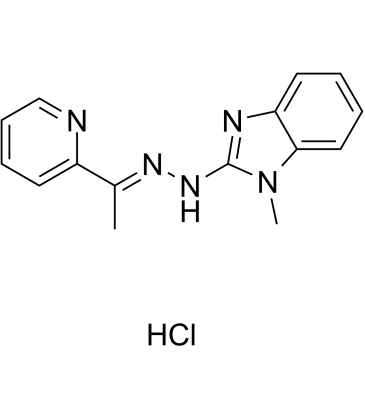1992052-49-9
| Name | SI-2 hydrochloride |
|---|
| Description | SI-2 hydrochloride (EPH 116 hydrochloride) is a highly promising SRC-3 SMI: SRC-3 inhibitor (PPI), with IC50 values of 3-20 nM for breast cancer cell death. SI-2 hydrochloride (EPH 116 hydrochloride) has a much improved toxicity and pharmacokinetic profile, with acceptable oral availability[1]. |
|---|---|
| Related Catalog | |
| Target |
IC50:3-20 nM (breast cancer cell death)[1]. |
| In Vitro | SI-2 selectively reduce the transcriptional activities and the protein concentrations of SRC-3 in cells through direct physical interactions with SRC-3[1]. SI-2 selectively induces breast cancer cell death with IC50 values in the low nanomolar range (3-20 nM), but not affect normal cell viability[1]. SI-2 (100 nM) decreases cell motility, invasion, and tumor metastasis in MDAMB-468 cells[1]. Cell Viability Assay[1]. Cell Line: MDA-MB-468 cells. Concentration: 100 nM. Incubation Time: 12 hours. Result: Significantly reduced the motility of cancer cells. Western Blot Analysis[1]. Cell Line: MDAMB-468 cells. Concentration: 0-200 nM. Incubation Time: 24 hours. Result: Significantly reduced SRC-3 protein levels. Did not decrease the SRC-3 mRNA level. Western Blot Analysis[1]. Cell Line: Cancer cells. Concentration: 0-200 nM. Incubation Time: 24 hours. Result: Caused PARP cleavage. |
| In Vivo | SI-2 causes minimal acute cardiotoxicity based on a hERG channel blocking assay and an unappreciable chronic toxicity to major organs based on histological analyses[1]. SI-2 is a drug-like molecule and meets all of the criteria of Lipinski’s rule[1]. Animal Model: MDA-MB-468 breast cancer mouse model[1]. Dosage: 2 mg/kg. Administration: Twice daily for 5 weeks (Vehicle, PBS). Result: Significantly inhibit tumor growth. SRC-3 levels in SI-2–treated tumor tissues were significantly lower than the PBS treated control group. Animal Model: CD1 mice[1]. Dosage: 20 mg/kg (Pharmacokinetic Analysis). Administration: Intraperitoneal administration once. Result: T1/2 = 1 h, Cmax of 3.0 μM, and the time to reach the maximum plasma concentration tmax of 0.25 h. SI-2 only degrades slightly (less than 5%) at pH 1.6 and 3.0 within 6 h, and is stable in buffers with pH ≥ 5. |
| References |
| Molecular Formula | C15H16ClN5 |
|---|---|
| Molecular Weight | 301.77 |
